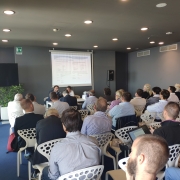Tips for maintaining the electrical system of a boat
/in News /by enaveDIY has an irresistible charm, no matter the context. Even among owners of recreational vessels, most prefer to fix any issues and malfunctions themselves, especially if they are perceived as minor. This includes those related to the electrical system.
The electrical system of boats
The electrical system of a boat is powered by direct current and generally consists of:
- Engine battery
- Service battery
- Battery isolator switch
- Distribution or control panels
Like almost every component of a boat, it needs to be periodically checked, especially if it’s not recently installed.
Many boaters prefer to do this independently and fix any possible faults themselves. This, in itself, isn’t a problem. However, if one isn’t very experienced, there’s a risk of causing more harm than good, jeopardizing onboard safety. Therefore, it’s important to have a good understanding of the basics of proper maintenance.
The basics of an electrical system: current and voltage
Firstly, let’s remember that:
- Voltage is measured in volts (V)
- Current is measured in amperes (A)
- Power is measured in watts (W)
- Resistance is measured in ohms (Ω)
We all know that high voltage can be lethal, but that doesn’t mean a system powered by only 12V or 24V, like that of most recreational boats, is less dangerous.
Many believe that, given the low value, they can touch the cables without much trouble. However, the current flowing through them often has very high amperage levels.
This explains why a household short circuit might create at most a small spark, perhaps blowing a fuse. On boats, however, a short circuit often leads to a strong flash, which risks setting fire to the cables because the released energy is much higher.
Things to keep in mind to prevent onboard fires
In the vast majority of cases, fires onboard a boat are caused by malfunctions in the electrical system.
Therefore, we must pay particular attention to the condition of cables, connectors, and batteries and replace them where necessary.
Also, as a general rule, remember that when the current is high, it’s important for the resistance to be low. So, we must ensure that:
- All connectors must be securely tightened.
- The fewer junctions, the better (each new junction adds some resistance).
Cables and Connectors
If you need to replace one or more cables, always prefer multi-stranded cables. Single-stranded wires, over time, tend to break more easily.
Also, it’s better to opt for tinned cables to prevent future corrosion.
Pay attention to the fuses too:
- There must be at least one.
- It must be compatible with the size of the cable (use the right tools, don’t try creative solutions, all components must be crimped well).
- It must burn out before the cable melts.
* To be sure not to cause trouble, you can buy pre-crimped cables at specialized stores.
Batteries: General Rules
Before discussing when to replace batteries, let’s look at some general assumptions regarding the battery bank:
- Batteries must be of the same type, age, and capacity.
- If you replace only one of the batteries, the new one will age faster, bringing it to the same level as the old one.
- At least two batteries are needed for the engine, or at least the ability to easily connect another battery if the engine one fails.
- The engine battery uses a lot of current for a short period of time.
- The service battery uses little current for a prolonged period of time.
Batteries: Optimizing Charge
If you’re not sailing for a while, remember that batteries should be left charged when not in use. In particular, concerning lead-acid batteries:
- If left unused with a 50% charge, they will last for another 200 cycles.
- If left charged at 70%, they will withstand another 1200 cycles.
AGM and Gel batteries, instead, have much longer charge cycles.
Also, if you want to extend the life of the batteries, make sure to:
- Have all connectors correctly crimped.
- Clean the battery bank once a year, check for signs of leaks or corrosion, check ventilation, and inspect fastening.
- Save energy by turning off utilities that you don’t use.
N.B: You can check the charge using a digital voltmeter showing at least two decimal places.
Batteries: Charging System
Another aspect to consider is how batteries are charged. Charging indeed takes time (typically a battery charges at about 10% per hour), so it’s important to have a quality charger that won’t damage them.
Moreover, the charger should be the first thing to connect to the power source once back in port (especially if you have a sailboat), and it never hurts to also rely on an external generator or alternative power source. Even a small solar panel with a charge controller, for example, can counteract battery self-discharge, thus avoiding the need to leave the boat connected to the shore power for long periods.
Lastly, remember that the older your boat is, the greater the need may be to change the electrical and charging system. This is especially true if you have added several new electrical devices over time (such as new lights, pumps, radar, TV, refrigerators, etc.), which can consume much more current, leaving less for battery charging.









